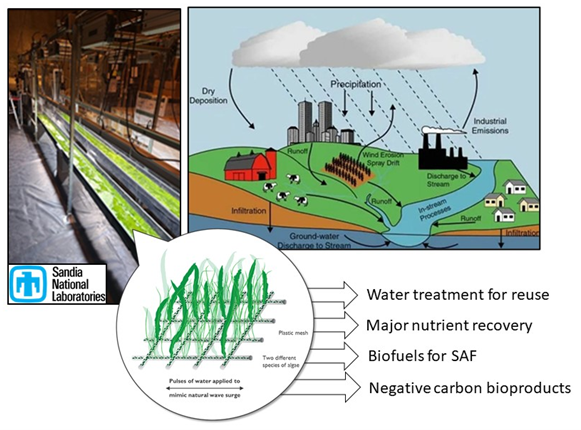Algae Scrubbing for Waterway Remediation and Biofuel Production
A novel algae flow-way system capable of converting wastewater pollutants into net-carbon negative biofuels
Waterway pollution has been aggravated by the leaking of chemical products into man-made water irrigation systems, natural streams, and rivers. Chemical pollutants such as fertilizer runoff from agricultural activities and trace metals from chemical processing are capable of stimulating the growth of harmful algae, resulting in a cycle known as eutrophication. To mitigate significant biological threats to both humans and aquatic ecosystems, Sandia researchers have devised a novel algae flow-way system for screening out pollutants before allowing the water to return to main water channels.
Sandia’s integrative algae flow-way system allows net-CO2 negative biofuel production from waste nutrients resulting from treating waterway. This system remediates (or reclaims) major nutrients, metals, and organic and inorganic carbon from surface waters. It consists of two separators at each end of the waterway to allow efficient flow-through and nutrient collection of water for the attached algae. The first water flow-through allows the attached algae to absorb nutrients and trace metals before flowing out to the other end. In addition, the flow-way system contains an embedded hinged container which allows automated harvest of the grown algae into a reservoir without using external power sources. Once harvested in the reservoir, the hinged container can return to its original position for further harvest of the rest of the algae. The flow-way system allows customized algae to grow alongside the device to collect fertilizer runoffs including nitrogen (N), phosphorus (P) and/or trace metal pollutants: arsenic, selenium, lead, mercury. Algae grown from the device can be further collected and processed for biomass production with an embedded hinged container within the system without the use of external power sources.
- Improved water quality: increased oxygen content, higher pH, reduced total suspended solids and biological oxygen demand
- Prevent and control harmful algae blooms
- Production of biomass and major nutrients
- Recovery of metals as well as organic/inorganic carbon from surface water
- Net CO2 negative biofuel production from waste nutrients
- Power plants
- Water treatment and recovery facilities
- Agriculture, irrigation, and run-off
- Residential pools and lakes

SD 15307
Published11/9/2020
Last Updated1/11/2024